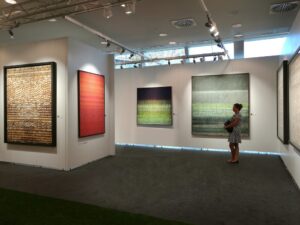The most well-known of Armén Rotch’s works are the collages and installations he makes with simple, even minimalistic patterns using tea bags. While others utilize tea bags to rest their weary eyes or as fertilizers in their gardens, Rotch transforms them with his creativity to give them a whole new striking purpose. He uses different tea bags each left in water for various amounts of time, thus creating varying layers of tonality within the pieces of the installation. Here, tea bags are being utilized as both leitmotiv (subject) and main technical material (object) which forms his art. Owing to his usage of this special material, the influence of Arte Povera could be felt, which is an Italian art movement, modest and bereft of any vanity; for which the artists use only the most simple and common materials.
Once seen as a luxurious item and traded internationally, finding its way all the way from China to Europe, the tea has a historical prominence – but in Rotch’s eyes it also has a place in almost every culture worldwide, and these tea bags that we use very often in our daily lives exemplify the lives and the existence of human beings. His works almost appear to have humility modesty, unlike the sense of smugness we often get in comtemporary art scene. What’s more is that they are intriguing and evocating, while possessing also a certain sensory element: The sense of smell, which animates or summons a series of memories.
In another production medium, Armén Rotch uses canvas to explore the pictorial processes specific to the representation of the temporal dimension on the image. After all the lines runs, traces and scratches on the canvas, come so many possible dimensions in which reminiscences and contradictions, certainties and hesitations, are found. This new pictorial field, where small separate pieces form a network of hesitations with irregular rhythms by binding together, hosts mutating instants by reflecting perception instead of the apprehension of time and depth instead of the experience of process. Here, Rotch, by using the same laconic and precise movements and even repeating them inescapably, experiences time as something moving forward to the rhythm of its inner temporality, apart from any circumstantial chronology



